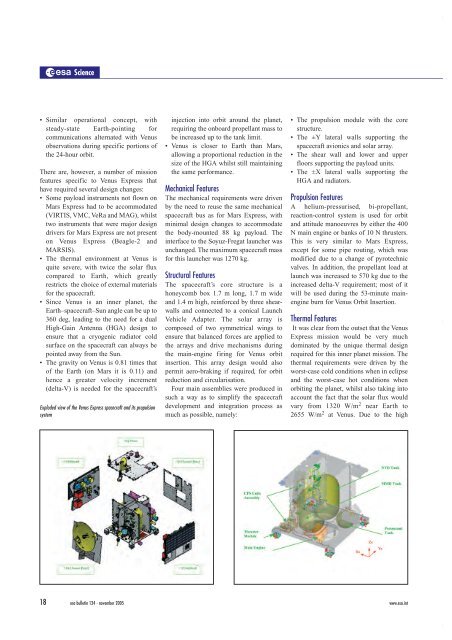The Spacecraft Venus Express - ESA
The Spacecraft Venus Express - ESA
The Spacecraft Venus Express - ESA
Create successful ePaper yourself
Turn your PDF publications into a flip-book with our unique Google optimized e-Paper software.
Science<br />
• Similar operational concept, with<br />
steady-state Earth-pointing for<br />
communications alternated with <strong>Venus</strong><br />
observations during specific portions of<br />
the 24-hour orbit.<br />
<strong>The</strong>re are, however, a number of mission<br />
features specific to <strong>Venus</strong> <strong>Express</strong> that<br />
have required several design changes:<br />
• Some payload instruments not flown on<br />
Mars <strong>Express</strong> had to be accommodated<br />
(VIRTIS, VMC, VeRa and MAG), whilst<br />
two instruments that were major design<br />
drivers for Mars <strong>Express</strong> are not present<br />
on <strong>Venus</strong> <strong>Express</strong> (Beagle-2 and<br />
MARSIS).<br />
• <strong>The</strong> thermal environment at <strong>Venus</strong> is<br />
quite severe, with twice the solar flux<br />
compared to Earth, which greatly<br />
restricts the choice of external materials<br />
for the spacecraft.<br />
• Since <strong>Venus</strong> is an inner planet, the<br />
Earth–spacecraft–Sun angle can be up to<br />
360 deg, leading to the need for a dual<br />
High-Gain Antenna (HGA) design to<br />
ensure that a cryogenic radiator cold<br />
surface on the spacecraft can always be<br />
pointed away from the Sun.<br />
• <strong>The</strong> gravity on <strong>Venus</strong> is 0.81 times that<br />
of the Earth (on Mars it is 0.11) and<br />
hence a greater velocity increment<br />
(delta-V) is needed for the spacecraft’s<br />
Exploded view of the <strong>Venus</strong> <strong>Express</strong> spacecraft and its propulsion<br />
system<br />
injection into orbit around the planet,<br />
requiring the onboard propellant mass to<br />
be increased up to the tank limit.<br />
• <strong>Venus</strong> is closer to Earth than Mars,<br />
allowing a proportional reduction in the<br />
size of the HGA whilst still maintaining<br />
the same performance.<br />
Mechanical Features<br />
<strong>The</strong> mechanical requirements were driven<br />
by the need to reuse the same mechanical<br />
spacecraft bus as for Mars <strong>Express</strong>, with<br />
minimal design changes to accommodate<br />
the body-mounted 88 kg payload. <strong>The</strong><br />
interface to the Soyuz-Fregat launcher was<br />
unchanged. <strong>The</strong> maximum spacecraft mass<br />
for this launcher was 1270 kg.<br />
Structural Features<br />
<strong>The</strong> spacecraft’s core structure is a<br />
honeycomb box 1.7 m long, 1.7 m wide<br />
and 1.4 m high, reinforced by three shearwalls<br />
and connected to a conical Launch<br />
Vehicle Adapter. <strong>The</strong> solar array is<br />
composed of two symmetrical wings to<br />
ensure that balanced forces are applied to<br />
the arrays and drive mechanisms during<br />
the main-engine firing for <strong>Venus</strong> orbit<br />
insertion. This array design would also<br />
permit aero-braking if required, for orbit<br />
reduction and circularisation.<br />
Four main assemblies were produced in<br />
such a way as to simplify the spacecraft<br />
development and integration process as<br />
much as possible, namely:<br />
• <strong>The</strong> propulsion module with the core<br />
structure.<br />
• <strong>The</strong> ±Y lateral walls supporting the<br />
spacecraft avionics and solar array.<br />
• <strong>The</strong> shear wall and lower and upper<br />
floors supporting the payload units.<br />
• <strong>The</strong> ±X lateral walls supporting the<br />
HGA and radiators.<br />
Propulsion Features<br />
A helium-pressurised, bi-propellant,<br />
reaction-control system is used for orbit<br />
and attitude manoeuvres by either the 400<br />
N main engine or banks of 10 N thrusters.<br />
This is very similar to Mars <strong>Express</strong>,<br />
except for some pipe routing, which was<br />
modified due to a change of pyrotechnic<br />
valves. In addition, the propellant load at<br />
launch was increased to 570 kg due to the<br />
increased delta-V requirement; most of it<br />
will be used during the 53-minute mainengine<br />
burn for <strong>Venus</strong> Orbit Insertion.<br />
<strong>The</strong>rmal Features<br />
It was clear from the outset that the <strong>Venus</strong><br />
<strong>Express</strong> mission would be very much<br />
dominated by the unique thermal design<br />
required for this inner planet mission. <strong>The</strong><br />
thermal requirements were driven by the<br />
worst-case cold conditions when in eclipse<br />
and the worst-case hot conditions when<br />
orbiting the planet, whilst also taking into<br />
account the fact that the solar flux would<br />
vary from 1320 W/m 2 near Earth to<br />
2655 W/m 2 at <strong>Venus</strong>. Due to the high<br />
18 esa bulletin 124 - november 2005 www.esa.int

















